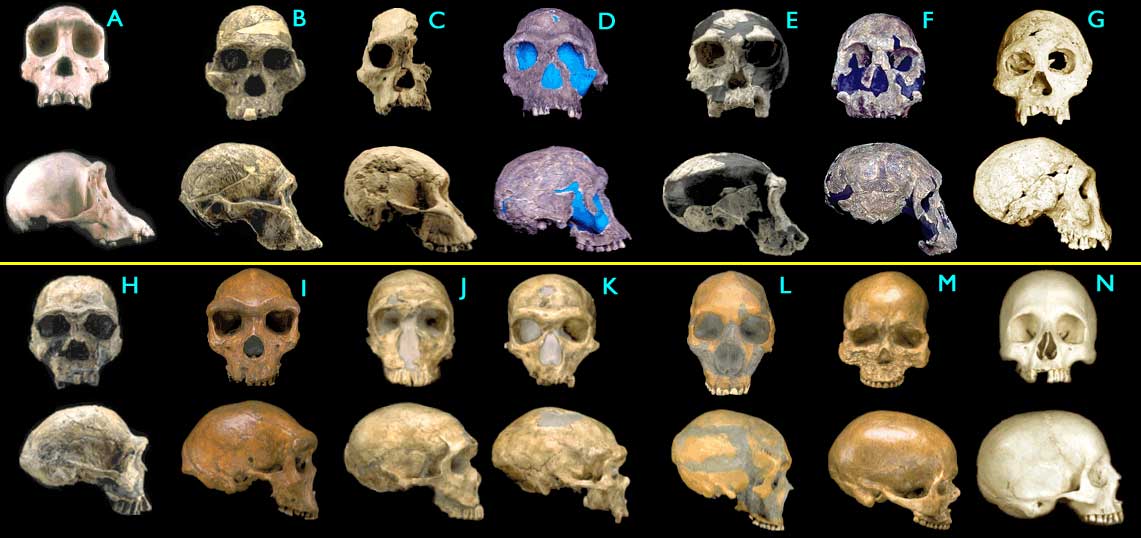To: stands2reason
Conclusion
In conclusion, our genus Homo appears to have been intelligently designed and is not connected to the australopithecine apes or any other apes through ancestry:
1. The alleged australopithecine ancestors are very different from the earliest members of Homo,
2. Homo appears suddenly and distinct, without transitions in the fossil record from any earlier forms, and
3. Subsequent forms of Homo are variants of and very similar to the initial forms of Homo.
Figure 9. A) An approximation of a common hominid phylogeny or family tree, under an evolutionary perspective. Adapted from reference 8. Many hominid phylogenies place Australopithecus afarensis arising from the hominid Ardipithicus ramidus a little over 4 million years ago. B) Hominid phylogeny under intelligent design, reflecting basic types among hominids. Basic type Homo is unrelated to basic type Australopithecus. Dates have been left off to illustrate only lines of ancestry.
http://www.ideacenter.org/contentmgr/showdetails.php/id/1146
Humans were and always have been humans.
222 posted on
04/27/2006 1:33:54 PM PDT by
mlc9852
To: mlc9852
In conclusion, our genus Homo appears to have been intelligently designed and is not connected to the australopithecine apes or any other apes through ancestry:
1. The alleged australopithecine ancestors are very different from the earliest members of Homo,
2. Homo appears suddenly and distinct, without transitions in the fossil record from any earlier forms, and
3. Subsequent forms of Homo are variants of and very similar to the initial forms of Homo.
|

|

|
|
Australopithecus afarensis |
Homo Habilis |
233 posted on
04/27/2006 1:44:41 PM PDT by
Junior
(Identical fecal matter, alternate diurnal period)
To: mlc9852
Humans were and always have been humans. And, in the photo below, where do you draw the line between human and non-human?
Between C and D, perhaps? Between I and M (ignoring the Neanderthals)?

Figure 1.4.4. Fossil hominid skulls. Some of the figures have been modified for ease of comparison (only left-right mirroring or removal of a jawbone). (Images © 2000 Smithsonian Institution.)
(A) Pan troglodytes, chimpanzee, modern
(B) Australopithecus africanus, STS 5, 2.6 My
(C) Australopithecus africanus, STS 71, 2.5 My
(D) Homo habilis, KNM-ER 1813, 1.9 My
(E) Homo habilis, OH24, 1.8 My
(F) Homo rudolfensis, KNM-ER 1470, 1.8 My
(G) Homo erectus, Dmanisi cranium D2700, 1.75 My
(H) Homo ergaster (early H. erectus), KNM-ER 3733, 1.75 My
(I) Homo heidelbergensis, "Rhodesia man," 300,000 - 125,000 y
(J) Homo sapiens neanderthalensis, La Ferrassie 1, 70,000 y
(K) Homo sapiens neanderthalensis, La Chappelle-aux-Saints, 60,000 y
(L) Homo sapiens neanderthalensis, Le Moustier, 45,000 y
(M) Homo sapiens sapiens, Cro-Magnon I, 30,000 y
(N) Homo sapiens sapiens, modern
300 posted on
04/27/2006 2:39:04 PM PDT by
Coyoteman
(Interim tagline: The UN 1967 Outer Space Treaty is bad for America and bad for humanity - DUMP IT!)
To: mlc9852
Hey mlc9852, do you agree with Casey Luskin's classification of apes vs. humans that you linked to in #222?
328 posted on
04/27/2006 3:04:14 PM PDT by
jennyp
(WHAT I'M READING NOW: "The Great Influenza" by Barry)
FreeRepublic.com is powered by software copyright 2000-2008 John Robinson


